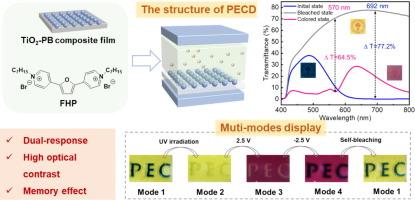光致变色和电致变色双响应器件:二氧化钛-普鲁士蓝复合材料与新型扩展紫胶的整合
IF 13.3
1区 工程技术
Q1 ENGINEERING, CHEMICAL
引用次数: 0
摘要
光致变色和电致变色器件因其低功耗、护眼和广泛的应用潜力而备受关注。然而,开发具有良好记忆效应和快速切换能力的双响应器件仍具有挑战性。在此,我们报告了一种基于二氧化钛-普鲁士蓝(PB)复合膜和新型扩展紫胶全氟辛烷磺酸的双响应光致变色器件(PECD)的新型制造策略。利用二氧化钛的光催化特性,我们成功地制备出了双响应薄膜,并将 FHP 作为一种补充材料加入其中,以提高该装置的性能。值得注意的是,所制备的 PECD 表现出卓越的性能,包括长光学记忆(33.91 小时)、快响应(着色 4.6 秒,漂白 10.4 秒)、高对比度(在 692 纳米波长下,ΔT 为 77.2%)和优异的循环稳定性(连续工作 1000 次后,ΔT 损失小于 3.1%),凸显了其在先进光学应用方面的潜力。本文章由计算机程序翻译,如有差异,请以英文原文为准。

Photochromic and electrochromic dual-responsive devices: Integration of TiO2-Prussian blue composites and novel extended viologen
Photochromic and electrochromic devices have attracted remarkable attention due to their advantages of low power consumption, eye-friendliness, and broad application potential. However, developing dual-responsive devices with nice memory effect and rapid switching ability remains challenging. Here we report a novel strategy for fabricating dual-responsive photo-electrochromic device (PECD) based on TiO2-Prussian blue (PB) composite film and a novel extended viologen FHP. Exploiting the photocatalytic properties of TiO2, we successfully fabricated dual-responsive thin films and incorporated FHP as a complementary material to enhance the performance of the device. Notably, the resultant PECD exhibited remarkable performance, including long optical memory (33.91 h), fast response (4.6 s for coloring, 10.4 s for bleaching), high contrast (ΔT is 77.2 % at 692 nm), and excellent cycling stability (ΔT loss is smaller than 3.1 % after continuous working for 1000 cycles), highlighting their potential for advanced optical applications.
求助全文
通过发布文献求助,成功后即可免费获取论文全文。
去求助
来源期刊

Chemical Engineering Journal
工程技术-工程:化工
CiteScore
21.70
自引率
9.30%
发文量
6781
审稿时长
2.4 months
期刊介绍:
The Chemical Engineering Journal is an international research journal that invites contributions of original and novel fundamental research. It aims to provide an international platform for presenting original fundamental research, interpretative reviews, and discussions on new developments in chemical engineering. The journal welcomes papers that describe novel theory and its practical application, as well as those that demonstrate the transfer of techniques from other disciplines. It also welcomes reports on carefully conducted experimental work that is soundly interpreted. The main focus of the journal is on original and rigorous research results that have broad significance. The Catalysis section within the Chemical Engineering Journal focuses specifically on Experimental and Theoretical studies in the fields of heterogeneous catalysis, molecular catalysis, and biocatalysis. These studies have industrial impact on various sectors such as chemicals, energy, materials, foods, healthcare, and environmental protection.
 求助内容:
求助内容: 应助结果提醒方式:
应助结果提醒方式:


